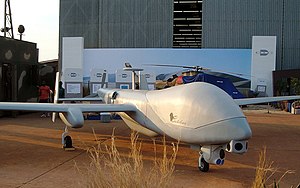
The AAI RQ-7 Shadow is an American unmanned aerial vehicle (UAV) used by the United States Army, Australian Army, Swedish Army, Turkish Air Force and Italian Army for reconnaissance, surveillance, target acquisition and battle damage assessment. Launched from a trailer-mounted pneumatic catapult, it is recovered with the aid of arresting gear similar to jets on an aircraft carrier. Its gimbal-mounted, digitally stabilized, liquid nitrogen-cooled electro-optical/infrared (EO/IR) camera relays video in real time via a C-band line-of-sight data link to the ground control station (GCS).

The Denel Dynamics Seeker is an unmanned aerial vehicle (UAV) manufactured in South Africa by Denel Dynamics. The system is designed to perform tactical reconnaissance in real time and can conduct day and night surveillance in all threat environments.
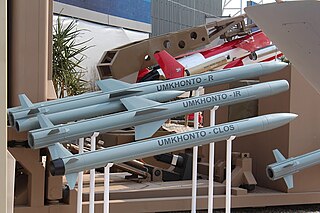
The Umkhonto is a South African family of modern short- to medium-range, all-weather-capable vertical launch (VLS) surface-to-air missiles (SAM) manufactured by South Africa's Denel Dynamics. The missile and associated subsystems are supplied as a missile group for easy integration into naval combat suites or ground-based air defence systems.
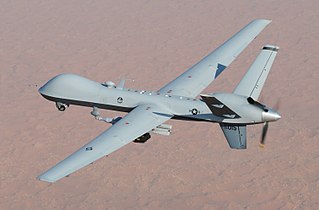
The General Atomics MQ-9 Reaper is an unmanned aerial vehicle (UAV) capable of remotely controlled or autonomous flight operations developed by General Atomics Aeronautical Systems (GA-ASI) primarily for the United States Air Force (USAF). The MQ-9 and other UAVs are referred to as Remotely Piloted Vehicles/Aircraft (RPV/RPA) by the USAF to indicate their human ground controllers.

The Northrop Grumman Bat is a medium-altitude unmanned air vehicle originally developed for use by the United States Armed Forces. Designed primarily as an intelligence "ISR" gathering tool, the Bat features 30 lb (14 kg) payload capacity that is unmatched in a 10 ft (3.0 m) wing span.

The DRDO Rustom is a Medium Altitude Long Endurance unmanned air vehicle (UAV) being developed by Defence Research and Development Organisation for the three services, Indian Army, Indian Navy and the Indian Air Force of the Indian Armed Forces. Rustom is derived from the NAL's LCRA developed by a team under the leadership of late Prof Rustom Damania in the 1980s. The UAV will have structural changes and a new engine. Rustom will replace/supplement the Heron UAVs in service with the Indian armed forces.
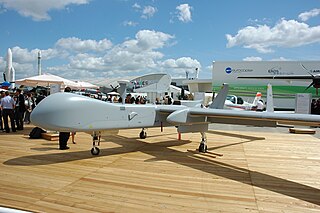
The EADS Harfang, formerly known as Système intérimaire de drone MALE is a drone system used by the French Air Force, supplementing the RQ-5 Hunter.
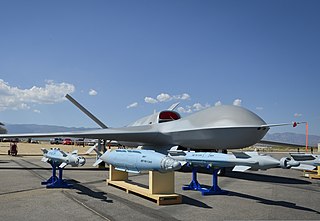
The General Atomics MQ-20 Avenger is a developmental unmanned combat air vehicle built by General Atomics Aeronautical Systems for the U.S. military.

The Arcturus T-20 unmanned aerial vehicle (UAV) is a medium range, fully composite aircraft capable of internal and external payloads. Launched from a portable catapult, it can be recovered with a shipboard landing system, or belly land on unimproved surfaces. The T-20 carries a retractable gimbal-mounted, digitally stabilized, electro-optical/infrared (EO/IR) camera that relays video in real time via a C-band LOS data link to the ground control station (GCS). Powered by a 4-stroke, fuel injected gasoline engine, the aircraft burns 2 lb (910 g) of fuel per hour at cruise. The T-20 does not require an airfield to operate and lands on dirt, grass, desert, or gravel roads. The internal payload bay allows for sensor arrays to be pre-assembled on 'payload pallets' that attach from the bottom of the aircraft. The T-20 system includes three aircraft, ground control station, portable launcher, and support trailer for equipment and personnel. The airframe is entirely composite with complex wet wings tested to stresses of 10 g (98 m/s2).
The Boeing Phantom Eye was a high altitude, long endurance (HALE) liquid hydrogen-powered unmanned aerial vehicle developed by Boeing Phantom Works. The aircraft was Boeing's proposal to meet the demand from the US military for unmanned drones designed to provide advanced intelligence and reconnaissance work, driven by the combat conditions in Afghanistan in particular. In August 2016, the Phantom Eye demonstrator was disassembled for display at the Air Force Flight Test Museum.

The EADS Talarion is a twinjet Medium-altitude long-endurance unmanned aerial vehicle, designed by EADS, to meet future European military needs for aerial reconnaissance, military intelligence, and aerial surveillance. EADS has run a preliminary design review, and is awaiting orders. The source of the name is the Talaria—the winged sandals of the Greek Messenger god Hermes.

The HESA Karrar is an Iranian jet-powered target drone manufactured by Iran Aircraft Manufacturing Industrial Company (HESA) since 2010. The Karrar is a derivative of the American 1970s-era Beechcraft MQM-107 Streaker target drone, probably incorporating elements from the South African Skua, with hardpoints added for munitions. But the reality is that this UAV is based on a domestic design without any foreign company. The Karrar was developed during the Ahmadinejad presidency.

The BZK-005 high-altitude, long-range UAV is a reconnaissance aircraft designed by Beijing University of Aeronautics & Astronautics and Harbin Aircraft Industry (Group) Co., Ltd. It is used by the PLA Navy and PLA Air Force.

TAI Gözcü is a radio-controlled short-range tactical drone. Designed, developed and built by Turkish Aerospace Industries (TAI), the unmanned aerial vehicle (UAV) is in use by the Turkish Armed Forces for intelligence, surveillance, target acquisition and reconnaissance purposes. Gözcü is the Turkish word for observer.

The Denel Dynamics Skua is a turbojet-engined target drone used to simulate fast-moving attack aircraft during surface-to-air and air-to-air training exercises and weapons tests. It is manufactured by the Denel Dynamics division of the South African state-owned Denel aerospace and defence conglomerate.
The Orion is a Medium-altitude long-endurance unmanned aerial vehicle (UAV) developed by Aurora Flight Sciences.

Tactical Airborne Platform for Aerial Surveillance-Beyond Horizon-201 or TAPAS BH-201 is a high-altitude long endurance unmanned aerial vehicle (UAV) which used to be previously referred as Rustom-II, being developed by India on the lines of the American Predator drones. First flight of the UAV took place in November 2016 after a 3-year delay. It was revealed at that time that the UAV has been renamed from Rustom-II to TAPAS-BH-201, an acronym for Tactical Airborne Platform for Aerial Surveillance-Beyond Horizon-201. The basic TAPAS BH-201 is classified as a medium-altitude long-endurance unmanned aerial vehicle

The European Medium Altitude Long Endurance Remotely Piloted Aircraft System is a twin-turboprop MALE UAV developed by Airbus, Dassault Aviation and Leonardo for Germany, France, Italy and Spain, to be introduced in 2025.

The TAI Aksungur is an unmanned aerial vehicle (UAV) built by Turkish Aerospace Industries (TAI) for the Turkish Armed Forces. Using existing technology from the TAI Anka series of drones, it is the manufacturer's largest drone with payload capacity for mission-specific equipment. It is intended to be used for long-term surveillance, signals intelligence, maritime patrol missions, or as an unmanned combat aerial vehicle. TAI planned to integrate weapon packages and put the Aksungur into production in early 2020. The first unit was delivered to the Turkish Naval Forces on 20 October 2021.
The Shahpar ll is an unmanned combat aerial vehicle (UCAV) built by Global Industrial Defence Solutions of Pakistan. It is currently in production following the completion of a test and qualification phase.
